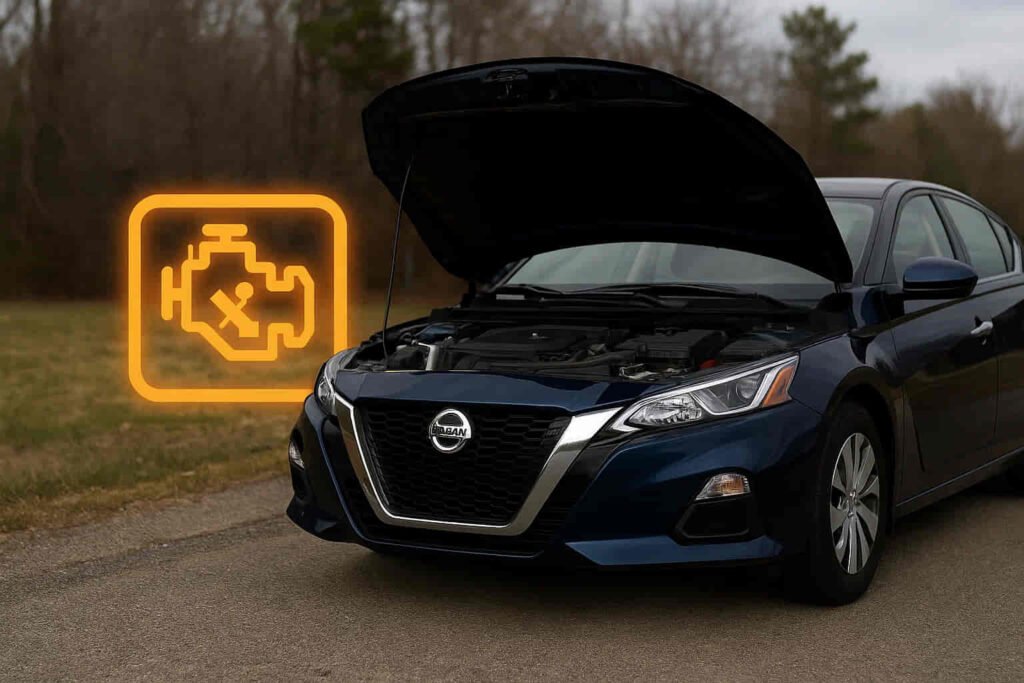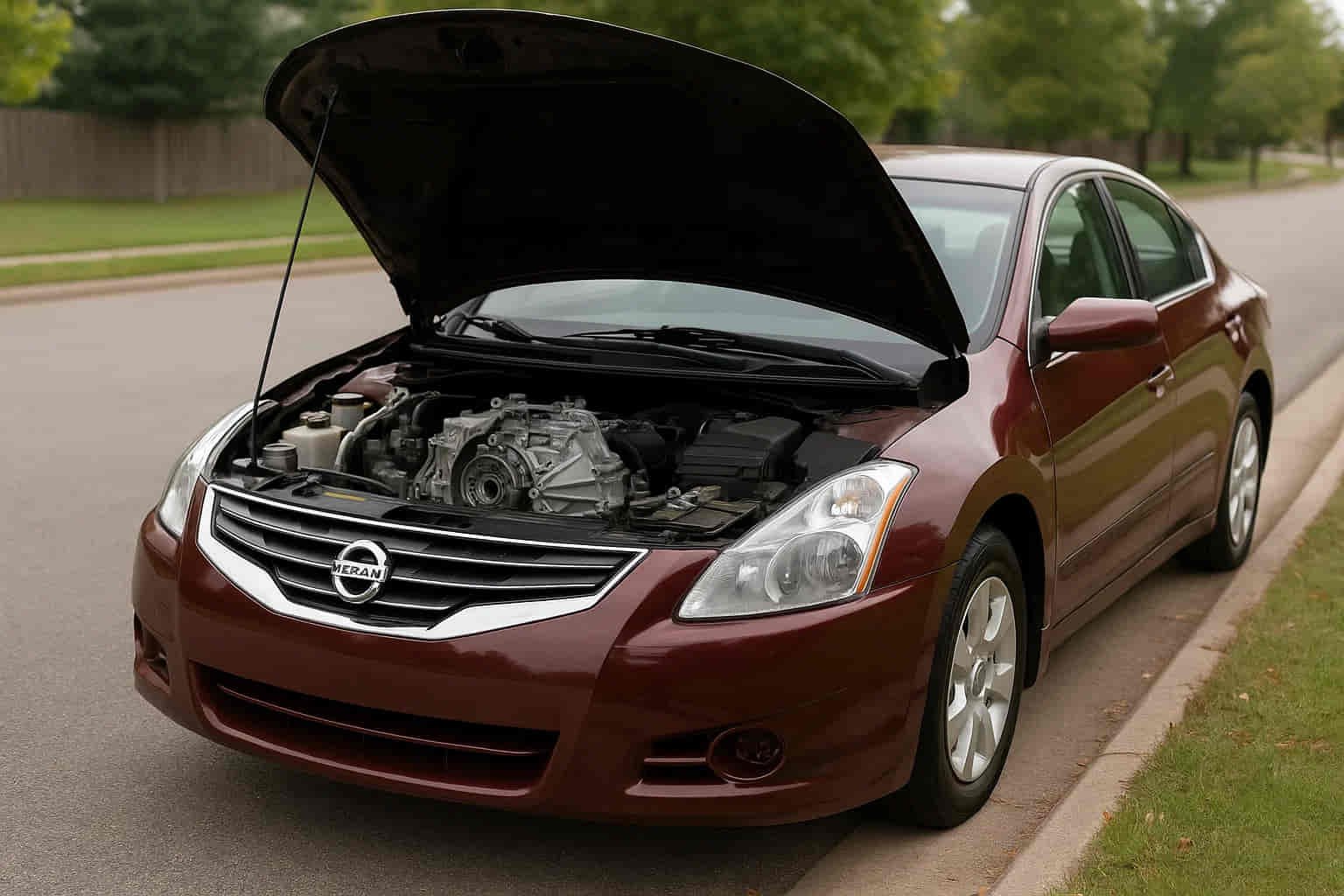Over the past two decades, the Nissan Altima has been both praised for its comfort and criticized for one recurring issue — its transmission. For many owners, the words “Nissan Altima transmission problems” are more than a rumor; they represent costly repairs, frustrating breakdowns, and unexpected performance drops. According to NHTSA data and thousands of owner reports, transmission failures have appeared in specific model years far more frequently than others.
Understanding Nissan Altima transmission problems by year is essential for anyone considering a used Altima. The type of transmission used — Nissan’s continuously variable transmission (CVT) — was designed for smoother acceleration and improved fuel efficiency, yet it has become a focal point of controversy. Early CVT systems from 2007 to 2012 suffered from overheating and belt slippage, while later models improved reliability but still faced scattered complaints.
In this guide, we’ll explore which model years of the Nissan Altima are most prone to CVT issues, why some versions are considered “years to avoid,” and which newer generations have finally achieved the reliability that Nissan promised. Whether you’re buying used or researching your current Altima, this year-by-year analysis will help you make a smarter, data-backed decision.
What Causes Nissan Altima Transmission Problems?
The root of most Nissan Altima transmission problems lies in the design and behavior of the continuously variable transmission (CVT) system. Unlike traditional automatics, the CVT uses a belt-and-pulley mechanism to deliver seamless gear ratios. While this technology improves fuel efficiency, it also introduces vulnerabilities when heat, pressure, and software calibration are not perfectly balanced.
In early Altima models, particularly between 2007 and 2012, the CVT was prone to overheating during long drives or in stop-and-go traffic. Excess heat caused the steel belt to expand and slip, resulting in jerky acceleration and whining noises. Once slippage occurred repeatedly, the internal fluid degraded rapidly, leading to total transmission failure.
Nissan attempted to resolve these issues in later models by introducing improved cooling systems and updated transmission control modules. However, even 2013–2018 Altimas continued to show sporadic complaints related to hesitation and delayed engagement, indicating that the core mechanical design remained sensitive to stress.
By 2019, with the arrival of the latest generation, Nissan’s CVT received a new adaptive logic system aimed at reducing friction and extending fluid life. Although this update significantly improved reliability, some owners of 2019–2020 models still reported occasional shuddering and vibration under acceleration, proving that CVT perfection remains an ongoing pursuit rather than a solved problem.
Nissan Altima Transmission Problems by Year

2007–2012 Nissan Altima (High Failure Rate)
The first-generation CVT-equipped Nissan Altima models, produced between 2007 and 2012, represent the most problematic years in the vehicle’s transmission history. These models marked Nissan’s early transition to CVT technology, a system that promised smoother performance but instead became notorious for frequent transmission failures.
Owners of 2008, 2009, and 2010 Altimas often reported slipping gears, whining noises, and sudden power loss after only 60,000 to 90,000 miles. The main culprit was overheating of the transmission fluid, which weakened the steel belt and caused pressure inconsistencies inside the gearbox. Once this cycle began, drivers experienced jerking movements during acceleration and a distinctive high-pitched whine, both indicators of internal wear.
According to NHTSA complaint data, these years recorded the highest volume of CVT-related issues in the entire Altima lineup. Many owners faced repair bills ranging from $3,000 to $4,500, often outside the standard warranty period. In response to widespread dissatisfaction, Nissan extended the CVT warranty from 60,000 to 120,000 miles — an unprecedented move that acknowledged the design flaw.
While regular maintenance could delay failure, the underlying issue lay in insufficient cooling capacity and limited fluid durability. As a result, 2007–2012 Altimas are generally listed among the “years to avoid” for used car buyers. Despite their comfort and fuel efficiency, their transmission reliability remains one of the weakest points in Nissan’s modern history.
2013–2018 Nissan Altima (Moderate Reliability)
The 2013–2018 Nissan Altima generation marked a turning point for the brand’s CVT technology. After years of customer complaints and negative press surrounding earlier models, Nissan invested heavily in software optimization and heat management. These updates helped stabilize performance, yet transmission problems persisted — just in subtler, less catastrophic forms.
During this era, many owners reported delayed acceleration, shuddering under light throttle, and occasional “rubber band” sensations while cruising. These issues were often traced to the transmission control module (TCM) and how it interpreted throttle input and load conditions. Although the updated CVT fluid and cooling system improved durability, long-distance drivers continued to experience overheating during extended highway use, suggesting that the underlying belt-driven design still struggled with sustained thermal stress.
Nissan released multiple Technical Service Bulletins (TSBs) to recalibrate the CVT’s shift logic and temperature thresholds, which temporarily resolved drivability concerns. Repair costs during this generation averaged between $2,500 and $3,800 — slightly lower than the previous models but still significant for mid-size sedan owners.
From a buyer’s perspective, the 2016 and 2017 model years stand out as the most balanced choices, offering fewer complaints and better long-term reliability ratings. These versions benefited from improved cooling systems and refined TCM programming, reducing the likelihood of early transmission failure. However, potential buyers should still verify service records and ensure that all software updates and fluid changes were performed on schedule to avoid repeating the same reliability issues that have defined Nissan’s CVT legacy.
2019–2025 Nissan Altima (Latest Generation)
With the launch of the 2019 redesign, Nissan aimed to silence years of criticism surrounding its CVT transmission. This generation introduced an upgraded Xtronic CVT system with adaptive shift logic, improved cooling pathways, and stronger internal components designed to resist belt slippage and fluid degradation. As a result, Nissan Altima transmission problems became significantly less common, marking a major step forward in reliability.
However, the early production years — particularly 2019 and 2020 — were not entirely free from issues. Some owners reported mild shuddering or vibration during light acceleration, often when the vehicle was cold or after extended highway driving. In most cases, these were linked to software calibration rather than mechanical failure. Nissan quickly released software patches through dealerships, and later models (2021 and newer) benefited from the updated CVT programming straight from the factory.
By 2022, the Altima’s transmission had achieved one of its best reliability ratings in over a decade. The system’s smarter fluid temperature regulation and torque converter tuning reduced wear and improved overall drivability. Extended warranties, along with more transparent maintenance schedules, helped rebuild consumer trust that had been eroded by previous generations.
Although perfection remains elusive for any CVT, the 2019–2025 Nissan Altima stands as the brand’s most dependable iteration yet. For drivers seeking a balance between smooth performance, fuel efficiency, and long-term dependability, these model years finally deliver the stability that earlier Altimas struggled to achieve.
Models with the Worst Nissan Altima Transmission Problems
Across more than fifteen years of production, certain Nissan Altima models stand out as clear examples of what went wrong with the brand’s CVT experiment. While every generation faced its share of reliability issues, the 2008, 2009, 2013, and 2014 model years consistently recorded the highest number of transmission complaints on platforms like NHTSA and CarComplaints.com.
The 2008 and 2009 Altimas were the first to expose the CVT’s thermal management weakness. Drivers frequently reported slipping, whining, and loss of acceleration, especially during long highway trips or in hot climates. Transmission fluid would overheat, leading to belt wear and eventual system failure — sometimes before 80,000 miles. These failures often required complete transmission replacements costing between $3,000 and $4,500, a financial blow that many owners faced without warranty coverage.
The 2013 and 2014 Altimas introduced a redesigned CVT intended to improve performance, yet software inconsistencies led to new problems — delayed gear response, sudden jerking, and vibrations at low speeds. These models also suffered from premature fluid contamination, which worsened drivability and reduced transmission lifespan.
Industry experts frequently label these years as the “worst Nissan Altima models to buy used.” Despite Nissan’s warranty extensions and software patches, the combination of flawed CVT engineering and high repair costs has made these vehicles notorious among mechanics and car reviewers alike. For prospective buyers, avoiding these model years remains the simplest way to escape the financial risk associated with early-generation CVTs.
Best Nissan Altima Years Without Major Transmission Issues
While early Nissan Altimas earned a reputation for unreliable transmissions, later model years demonstrate that the automaker eventually learned from its past mistakes. The 2016, 2017, and 2022–2025 Nissan Altima models represent a turning point, combining refined engineering, smarter software, and more durable materials to minimize CVT failures.
The 2016 and 2017 Altimas were the first to show meaningful improvement. Nissan had recalibrated the Transmission Control Module (TCM) to optimize fluid pressure and gear ratio timing, which significantly reduced slipping and hesitation during acceleration. These mid-cycle updates also included a more efficient fluid cooling system, making the CVT less vulnerable to overheating during heavy use or summer driving. Owners of these models report smoother performance and fewer repair incidents compared to earlier generations.
Jumping ahead to the 2022 and newer Altimas, Nissan integrated a next-gen Xtronic CVT with advanced adaptive logic that “learns” from driving behavior. Combined with higher-quality transmission fluid and extended service intervals, these models have shown the lowest rate of CVT-related complaints on record. In reliability surveys, 2022+ Altimas score well above average within their class, rivaling competitors like the Honda Accord and Toyota Camry.
For buyers considering a used Altima, these years offer the best blend of affordability and long-term dependability. Regular maintenance — particularly fluid changes every 40,000–60,000 miles — remains essential, but with these models, Nissan has finally delivered on its promise of a smooth, durable, and efficient CVT driving experience.
How to Prevent Transmission Failure in Nissan Altima
Preventing transmission failure in a Nissan Altima starts with understanding how the CVT behaves under stress and what factors accelerate wear. Unlike traditional automatics, Nissan’s Xtronic CVT relies heavily on clean, temperature-stable fluid to keep the belt and pulleys operating smoothly. Once that balance is disrupted by heat or contamination, failure is only a matter of time.
The most effective way to protect your transmission is through regular CVT fluid maintenance. Despite Nissan’s “lifetime fluid” marketing, experienced technicians and independent mechanics recommend replacing CVT fluid every 40,000–60,000 miles, especially for vehicles driven in hot or congested environments. Using genuine Nissan NS-3 fluid is critical, as off-brand substitutes can alter pressure calibration and cause slippage.
Drivers should also avoid aggressive acceleration and prolonged idling, both of which generate excess heat and strain the transmission’s hydraulic system. Keeping the cooling system in good condition — including the radiator and transmission cooler — helps maintain optimal operating temperatures.
Finally, owners are encouraged to check for Technical Service Bulletins (TSBs) and software updates issued by Nissan. These updates often include calibration improvements that correct early signs of hesitation or jerking. By combining proactive maintenance with smart driving habits, Altima owners can significantly extend their CVT’s lifespan and avoid the costly repairs that have historically plagued earlier generations.
Conclusion
After years of trial and error, the story of Nissan Altima transmission problems by year reveals a clear evolution — from early mechanical flaws to gradual engineering maturity. The first CVT generations from 2007 to 2012 exposed the risks of adopting new technology too quickly, while the 2013–2018 models showed incremental progress but remained imperfect. It wasn’t until the 2019 redesign that Nissan truly began restoring driver confidence with a far more stable and adaptive Xtronic CVT system.
For used car buyers, this history matters. Choosing a 2016, 2017, or 2022+ Altima can mean the difference between years of trouble-free driving and expensive transmission repairs. Meanwhile, avoiding high-risk years like 2008, 2009, 2013, and 2014 remains a smart, data-backed decision supported by thousands of owner reports and reliability studies.
Ultimately, transmission reliability in the Altima isn’t just about luck — it’s about awareness. By understanding the evolution of the CVT design, following maintenance schedules, and verifying recall or software updates, owners can prevent the same costly mistakes that defined earlier generations. Whether you’re buying, selling, or maintaining an Altima, informed choices will always be your strongest protection on the road.

